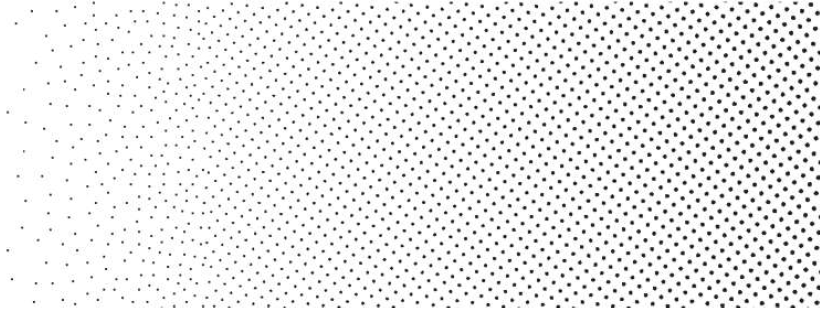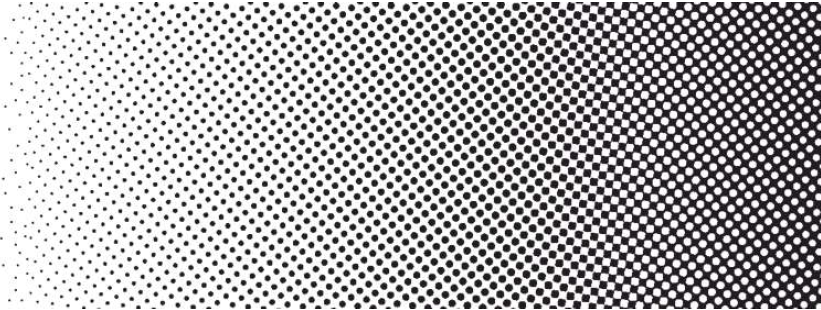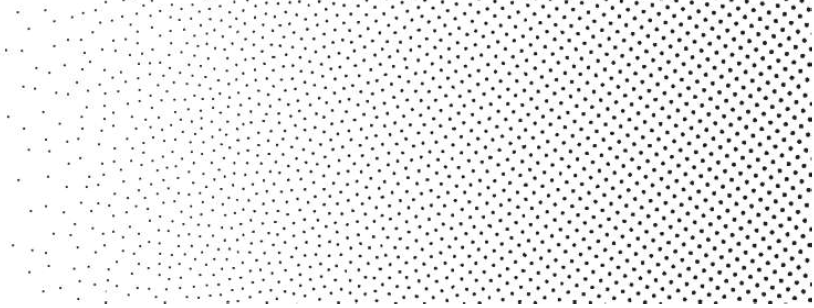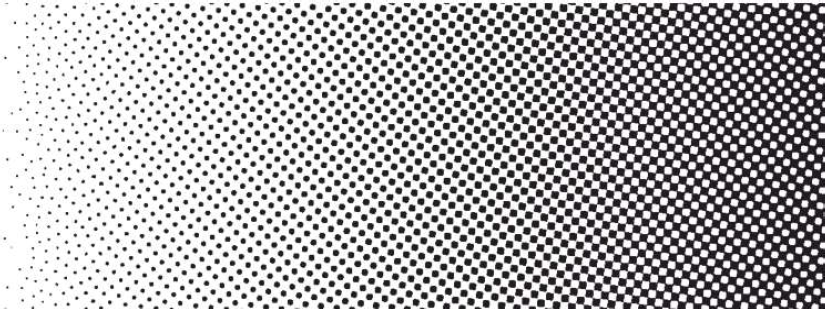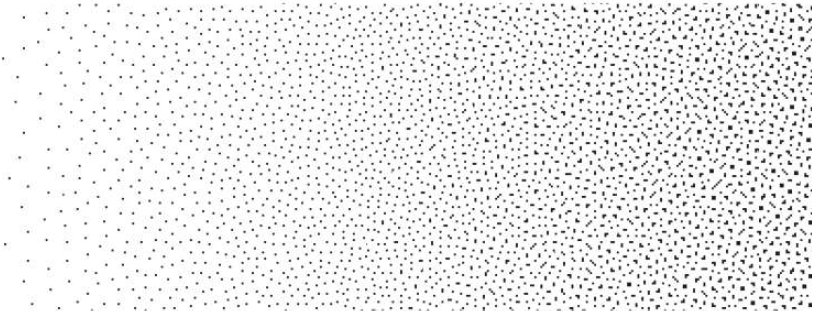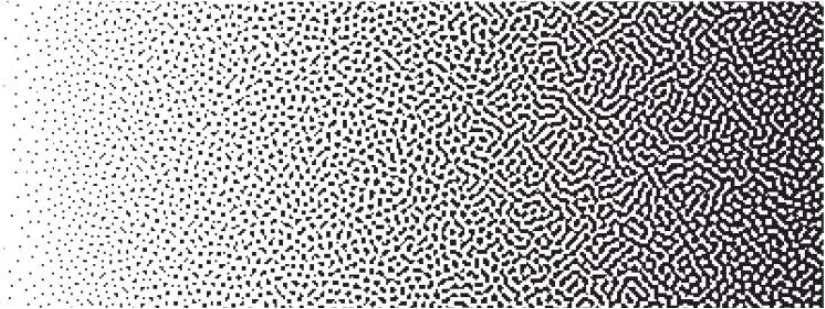Prinergy supports traditional AM (amplitude modulated), FM (frequency modulated), and hybrid (AM and FM mixed) screening. The Maxtone family is based on the Prinergy AM (conventional or rational tangent) screening technology, and the Staccato family is based on FM (also called staccato) screening technology. Hybrid Maxtone screening options combine these screening technologies.
Maxtone
Maxtone provides the standard AM screen through the entire tonal range, with a wide choice of rulings, angles, and dot shapes.
Maxtone CX
Maxtone CX hybrid AM screening enables printers to configure the size of highlight and shadow dots to suit the resolution-rendering capabilities of their output device, plate, and pressroom.
Maxtone CX uses AM screening to create tonal values above the configured minimum dot size. Once the minimum dot size is reached, Maxtone CX uses an FM-like technique to progressively remove minimum-sized dots from the AM grid. This technology allows flexo printing to achieve increased highlight values, using the minimum printable dot size.
The dots in Maxtone CX are arranged on the same screen-ruling grid as Maxtone screens, and tonality in the midtones is controlled by adjusting the size of the dots. However, for Maxtone CX, tonality in the highlights and shadows is controlled by fixing the dot width and varying the number or frequency of dots placed on the grid.
Maxtone CX is particularly useful in resolution-limited applications in which Maxtone highlight or shadow dots are not rendered reliably or consistently. For example, Maxtone CX is useful in flexo packaging, where highlight scum dots do not print reliably, in heatset web applications, and where highlight dots do not have the same run-length durability as the midtones.
Maxtone CX can also be used for high-screen-ruling commercial offset applications to avoid issues with single pixel dots on plate and on press.
Maxtone FX
Maxtone FX refers to hybrid AM screening for Flexcel NX, but may also be useful for offset applications with limited highlight resolution. Most of the tonal range uses traditional Maxtone AM screening in order to achieve mottle-free overprints in the midtones, while extreme highlights and shadows are screened with FM patterns to allow smooth highlight areas with larger dot sizes.
Maxtone FX gives you a choice of AM screening for the midtones, and the ability to control the minimum highlight and shadow dot sizes. In the midtones, it is identical to regular Maxtone AM screening. In the extreme highlights and shadows, there is a transition between fully AM behavior and fully FM behavior. The dot size is fixed at the minimum size that you specify, and the distribution of dots becomes FM in nature.
The Maxtone FX hybrid screen provides a quite rapid transition between AM screening in the midtones and stochastic FM screening in the highlights and shadows. To control the width of the area rendered with FM dots of the minimum size, you can configure the minimum dot size (from 1×1 to 4×4 pixels). The minimum dot size and screen ruling are independent of each other.
Maxtone FX is best suited for low-gain applications with small (1×1, 1×2 or 2×2) feature sizes—the FM area provides a smooth tone transition to the substrate while maintaining a Maxtone-type screen in the AM areas. Slight graininess may be associated with the FM areas.
The transition from FM to AM is quite rapid, which may become more apparent with larger minimum feature sizes. Maxtone FX may therefore be of limited benefit in high-gain applications that require a larger minimum feature size.
Examples
Maxtone FX highlight
Maxtone FX scale
Maxtone SX
Maxtone SX refers to hybrid AM screening that is designed primarily for Flexcel NX, but may also be useful for offset applications with limited highlight resolution. Most of the tonal range uses traditional Maxtone AM screening in order to achieve mottle-free overprints in the midtones, while extreme highlights and shadows are screened with FM patterns to allow smooth highlight areas with larger dot sizes.
Maxtone SX gives you a choice of AM screening for the midtones, and the ability to control the minimum highlight and shadow dot sizes. In the midtones, it is identical to regular Maxtone AM screening. In the extreme highlights and shadows, there is a transition between fully AM behavior and fully FM behavior. The dot size is fixed at the minimum size that you specify, and the distribution of dots becomes FM in nature.
The Maxtone SX hybrid screen provides a gradual transition between AM screening in the midtones and FM screening in the highlight and shadows. While dot placement in the FM areas is random and in the AM areas is nearly exactly on grid, the stochastic FM screen pattern and the AM grid pattern are gradually combined in the transition areas. The gradual transition from one behavior to the next eliminates the objectionable visual artifact that may occur with a fast transition.
To control the width of the area rendered with FM dots of the minimum size, you configure the minimum dot size (from 1×2 to 4×4 pixels). The minimum dot size and screen ruling are independent of each other.
Maxtone SX is suited for high-gain applications—the blended FM-to-AM transition enables the use of larger minimum feature sizes while providing a smooth tone transition to the substrate. Graininess may occur in FM-to-AM transition areas of the tone scale.
Examples
Maxtone SX highlight
Maxtone SX scale
Maxtone IS
Maxtone IS (Irrational Tangent Screening) is used for specialized imaging purposes, such as seamless flexographic sleeves and cylinders, direct cylinder engraving, and gravure imaging applications. IS screen systems are predefined in a screen set editor and cannot be modified in the process template. For information about defining IS screen sets, see the Prinergy System Administration Guide. To see how items in the list of IS screen systems can be hidden, see Hiding IS screen sets.
Maxtone IS CX
Maxtone IS CX hybrid AM screening enables printers to configure the size of highlight and shadow dots to suit the resolution-rendering capabilities of their output device, plate, and pressroom, when using Maxtone IS (Irrational Tangent Screening).
Maxtone IS is used for specialized imaging purposes, such as seamless flexographic sleeves and cylinders, direct cylinder engraving, and gravure imaging applications. Most IS screen parameters are predefined in a screen set editor and cannot be modified in the process template. For information about defining IS screen sets, see the Prinergy System Administration Guide. To see how items in the list of IS screen systems can be hidden, see Hiding IS screen sets.
Maxtone IS CX uses AM screening to create tonal values above the configured minimum dot size. Once the minimum dot size is reached, Maxtone IS CX uses an FM-like technique to progressively remove minimum-sized dots from the AM grid. This technology allows flexo printing to achieve increased highlight values, using the minimum printable dot size.
The dots in Maxtone IS CX are arranged on the same screen-ruling grid as Maxtone screens, and tonality in the midtones is controlled by adjusting the size of the dots. However, for Maxtone IS CX, tonality in the highlights and shadows is controlled by fixing the dot width and varying the number or frequency of dots placed on the grid.
Maxtone IS CX is particularly useful in resolution-limited applications in which Maxtone highlight or shadow dots are not rendered reliably or consistently. For example, Maxtone IS CX is useful in flexo packaging, where highlight scum dots do not print reliably, in heatset web applications, and where highlight dots do not have the same run-length durability as the midtones.
Maxtone IS CX can also be used for high-screen-ruling commercial offset applications to avoid issues with single pixel dots on plate and on press.
Staccato
Staccato screening is a stochastic, or frequency-modulated (FM), screening solution that can be purchased as an option to Prinergy. The combination of the Staccato screening software and the Kodak SQUAREspot technology gives you a level of control in the printing process that makes stochastic screening viable for routine presswork.
The demands that stochastic screening places on time and equipment mean it is not usually a practical solution for everyday print production. It is difficult for many printers to deliver stochastic screening with conventional output devices, because these devices do not offer the control required in the calibration, development, and platemaking processes. Staccato, however, makes FM screening a practical option for your routine presswork. You can also mix Staccato screens with conventional screens.
For more detailed information about Staccato screening, see the Staccato User Guide.
Staccato NX
Staccato NX is a configurable second-order FM screening intended for use with Flexcel NX media for packaging applications.
Staccato NX introduces FM screens for use with Flexcel NX media to address the needs of the packaging sector. In particular, it lets you use extended color sets (beyond CMYK), while avoiding AM screening moiré in the overprints.
Note: Staccato NX has only been qualified for Flexcel NX media and the Trendsetter NX, and is only available at a resolution of 2400 dpi.
Staccato NX consists of a set of preconfigured FM screens that can be selected in Prinergy. Staccato NX gives you a choice of minimum highlight and shadow dot size or dot width, and a choice of midtone frequencies. Screens are specified in terms of pixels for minimum highlight and shadow dot size, and equivalent line screen ruling (lines per inch) for midtone frequency.
The Staccato NX second-generation stochastic screen allows the highlight and shadow sizes to be configured separately from the midtone sizes.
- The highlight and shadow feature sizes are derived from the minimum feature size settings.
- The midtone feature size is expressed as an AM frequency midtone equivalent.
Examples
Staccato NX highlight
Staccato NX scale
See Also
